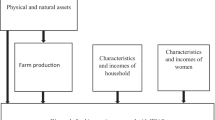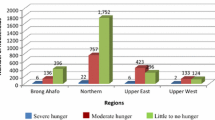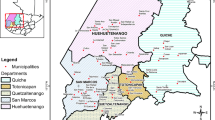Abstract
We interviewed 395 subsistence farming households from Chitwan, Nepal in order to identify the impact of remittances and other explanatory variables on child, adult, and household food security. The highest category of the IV - ordered probit regression models with cluster robust standard errors indicated that the food security status of households, adults and children was explained by gender and age of household head, adoption of conservation agricultural technology, number of fruit trees, and income from agricultural and livestock sources. Additional variables affecting only children’s food security were the adoption of hybrid rice or maize varieties and the wage income or salary earned within the district, whereas an additional variable affecting only household and adult food security was the wage income earned outside the district. Households receiving international remittances were more food secure than those households that did not receive such remittances.

Similar content being viewed by others

Notes
Global Hunger Index (GHI) is calculated each year by the International Food Policy Research Institute (IFPRI). GHI combines three equally weighted indicators: undernourishment, child underweight and children mortality and ranks countries on a 100-point scale where zero is the best (no hunger) and 100 is the worst.
In this study “remittances” represents the “international remittances income” unless specified otherwise. Although we controlled for the “internal remittances income” to avoid any potential bias, the aim of our research was to understand the role of international remittances in food security in the international remittances based economy.
Exchange rate U.S.$1 = NRs 98.28 (As of October 2, 2014).
In 2014, two more municipalities (Khairahani and Chitrawan) have been added, taking the total number of municipalities in the district to four.
High polychoric coefficients among three groups of food security indices indicate the need to estimate the model using a system of equations approach. However, we do not have unique variables for each food security groups. When explanatory variables are the same among three equations, there is no gain in efficiency by estimating the model in a seemingly unrelated fashion.
References
Adams Jr., R. H., & Page, J. (2005). Do international migration and remittances reduce poverty in developing countries? World Development, 33(10), 1645–1669.
Agarwal, S., Sethi, V., Gupta, P., Jha, M., Agnihotri, A., & Nord, M. (2009). Experiential household food insecurity in an urban underserved slum of North India. Food Security, 1(3), 239–250.
Ajani, S. R., Adebukola, B. C., & Oyindamola, Y. B. (2006). Measuring household food insecurity in selected local government areas of Lagos and Ibadan. Nigeria. Pakistan Journal of Nutrition, 5(1), 62–67.
Asian Development Bank (ADB). TA 7762-NEP Preparation of the Agricultural Development Strategy –Final Report (2013). Internet site: http://www.adb.org/projects/documents/agricultural-development-strategy-finalreport. Accessed 23 Jan 2014.
Babatunde, R. O., Omotesho, O. A., & Sholotan, O. S. (2007). Socio-economic characteristics and food security status of farming households in Kwara State, North-Central Nigeria. Pakistan Journal of Nutrition, 6(1), 49–58.
Banga, R., & Sahu, P. K. (2010). Impact of remittances on poverty in developing countries. UNCTAD, United Nations, Switzerland.
Ben-Akiva, M. E., & Lerman, S. R. (1985). Discrete choice analysis: theory and application to travel demand (Vol. 9). Cambridge, MA. MIT Press.
Brown, R. P., & Leeves, G. (2011). Comparative effects of migrants’ remittances on composition of recipient household income in two small, island economies. Applied Economics, 43(27), 3965–3976.
Carletto, C., Covarrubias, K., & Maluccio, J. A. (2011). Migration and child growth in rural Guatemala. Food Policy, 36(1), 16–27.
Central Bureau of Statistics. (2005). Poverty trend in Nepal (1995–96 and 2003–04). Kathmandu: Government of Nepal/National Planning Commission Secretariat.
Central Bureau of Statistics (CBS). (2011). Nepal Living Standard Survey (NLSS) 2010/11. Kathmandu: Government of Nepal/National Planning Commission Secretariat.
Crush, J. (2013). Linking food security, migration and development. International Migration, 51(5), 61–75.
Department of Foreign Employment (DOFE). (2010). Annual progress report 2010 (in Nepali language). Kathmandu: Government of Nepal/Ministry of Labour and Employment.
Environmental Systems Research Institute (ESRI). (2014). ArcGIS Release 10.2.2. Redlands, CA.
Esturk, O., & Oren, M. N. (2014). Impact of household socio-economic factors on food security: Case of Adana. Pakistan Journal of Nutrition, 13(1), 1–6.
Fafchamps, M., & Shilpi, F. (2013). Determinants of the choice of migration destination. Oxford Bulletin of Economics and Statistics, 75(3), 388–409.
Feder, G., Just, R. E., & Zilberman, D. (1985). Adoption of agricultural innovations in developing countries: A survey. Economic Development and Cultural Change, 33(2), 255–298.
Food and Agriculture Organization (FAO) (1996). Declaration on world food security. World Food Summit, FAO, Rome.
Food and Agriculture Organization (FAO) (2012). The state of food insecurity in the world 2012. Economic growth is necessary but not sufficient to accelerate reduction of hunger and malnutrition. Internet site: http://www.fao.org/docrep/016/i3027e/i3027e.pdf. Accessed 2 May 2013.
Food and Agriculture Organization (FAO) (2013). The state of food insecurity in the world 2013. The multiple dimensions of food security. Internet site: http://www.fao.org/docrep/018/i3434e/i3434e.pdf. Accessed 30 Dec 2013.
Frost, P., Campbell, B., Mutamba, M., Mandondo, A., & Kozanayi, W. (2007). In search of improved rural livelihoods in semi-arid regions through local management of natural resources: Lessons from case studies in Zimbabwe. World Development, 35(11), 1961–1974.
Garrett, J. L., & Ruel, M. T. (1999). Are determinants of rural and urban food security and nutritional status different? Some insights from Mozambique. World Development, 27(11), 1955–1975.
Generoso, R. (2015). How do rainfall variability, food security and remittances interact? The case of rural Mali. Ecological Economics, 114, 188–198.
Gulliford, M. C., Nunes, C., & Rocke, B. (2006). The 18 household food security survey items provide valid food security classifications for adults and children in the Caribbean. BMC Public Health, 6(1), 26.
Hu, F. (2013). Does migration benefit the schooling of children left behind?: Evidence from rural northwest China. Demographic Research, 29, 33–70.
International Food Policy Research Institute (IFPRI) (2012). Global Hunger Index 2012. The challenge of hunger: Ensuring sustainable food security under land, water and energy stresses. Internet site: http://www.ifpri.org/sites/default/files/publications/ghi12.pdf. Accessed 3 May 2013.
International Fund for Agricultural Development (IFAD) (2013). Nepal country programme evaluation 2013. Internet Site: https://www.ifad.org/documents/10180/58c575dc-e6a9-439b-bb2b-420c0f1b9203. Accessed 27 Feb 2014.
Kiawu, J. A. F., & Jones, K. G. (2013). Implications of food aid and remittances for west African food import demand. African Journal of Agricultural and Resource Economics, 8(1), 30–44.
King, R. (2012). Theories and typologies of migration: an overview and a primer. Willy Brandt Series of Working Papers in International Migration and Ethnic Relations 3/12. Malmö Institute for Studies of Migration, Diversity and Welfare (MIM) Malmö University.
Kuuire, V., Mkandawire, P., Arku, G., & Luginaah, I. (2013). ‘Abandoning’farms in search of food: food remittance and household food security in Ghana. African Geographical Review, 32(2), 125–139.
Lacroix, T. (2011). Migration, rural development, poverty and food security: A comparative perspective. Accessed from the web https://halshs.archives-ouvertes.fr/halshs-00921812/document
Lee, E. S. (1966). A theory of migration. Demography, 3(1), 47–57.
Long, J. S., & Freese, J. (2006). Regression Models for Categorical Outcomes Using Stata. 2nd ed. College Station, TX: Stata Press.
Lucas, R. E., & Stark, O. (1985). Motivations to remit: Evidence from Botswana. The Journal of Political Economy, 93(5), 901.
Massey, D. S., Goldring, L., & Durand, J. (1994). Continuities in transnational migration: An analysis of nineteen Mexican communities. American Journal of Sociology, 99(6), 1492–1533.
McKenzie, D. (2005). Beyond remittances: The effects of migration on Mexican households. In Ç. Özden & M. Schiff (Eds.), International migration, remittances, and the brain drain. New York: Palgrave Macmillan.
Ministry of Finance (MOF). (2012). Economic survey, fiscal year 2011/12. Kathmandu: Ministry of Finance, Government of Nepal.
Minnesota Department of Agriculture (MDA) (2013). Animal unit calculation worksheet. Internet site: http://www.mda.state.mn.us/animals/feedlots/feedlot-dmt/feedlot-dmt-animal-units.aspx. Accessed 18 Dec 2013.
Mora, J., & Taylor, J. E. (2005). Determinants of migration, destination and sector choice: Disentangling individual, household and community effects. In Ç. Özden & M. Schiff (Eds.), International migration, remittances, and the brain drain (p. 2005). New York: Palgrave Macmillan.
Munshi, K. (2001). Identification of network effects: Mexican migrants in the US labor market. Boston: NEUDC Conference.
Nepal Institute of Development Studies (NIDS) (2010). Nepal migration year book 2010. Internet site: http://www.sasnet.lu.se/sites/default/files/pdf/migration_year_book_2068.indd.pdf. Accessed 16 Feb 2014.
Pellegrini, P. A., & Fotheringham, A. S. (2002). Modelling spatial choice: A review and synthesis in a migration context. Progress in Human Geography, 26(4), 487–510.
Pyakuryal, B., Roy, D., & Thapa, Y. B. (2010). Trade liberalization and food security in Nepal. Food Policy, 35(1), 20–31.
Regmi, M., & Paudel, K. P. (2016). Impact of RemittanceRemittances on Food Security in Bangladesh. Food Security in a Food Abundant World (Frontiers of Economics and Globalization, Volume 16) Emerald Group Publishing Limited, 16, 145–158.
Roodman, D. (2011). Fitting fully observed recursive mixed-process models with cmp. Stata Journal, 11(2), 159–206.
Seddon, D., Jagannath, A., & Gurung, G. (2002). Foreign labor migration and the remittance economy of Nepal. Critical Asian Studies, 34(1), 19–40.
Sharma, S. (1999). Land tenure and poverty in Nepal. In WDR-2000 consultation meeting organized by the World Bank.
Sseguya, H. (2009). Impact of social capital on food security in southeast Uganda. Unpublished manuscript. Iowa State University, Ames, available at: http://lib.dr.iastate.edu/etd/10747/. Accessed 14 April 2015.
Stark, O., & Bloom, D. E. (1985). The new economics of labor migration. American Economic Review, 75(2), 173–178.
Stark, D., & Taylor, J. E. (1991). Migration incentives, migration types: The role of relative deprivation. The Economic Journal, 101(408), 1163–1178.
Taylor, E. J. (1999). The new economics of labour migration and the role of remittances in the migration process. International Migration, 37(1), 63–88.
Thieme, S., & Wyss, S. (2005). Migration patterns and remittance transfer in Nepal: A case study of Sainik Basti in western Nepal. International Migration, 43(5), 59–98.
United States Department of Agriculture (USDA) (2012). U.S. household food security survey module: three-stage design, with screeners. Internet site: http://www.ers.usda.gov/datafiles/Food_Security_in_the_United_States/Food_Security_Survey_Modules/hh2012.pdf. Accessed 14 Jan 2013.
Wagle, U. R. (2010). Economic inequality in Nepal: Patterns and changes during the late 1990s and early 2000s. Journal of Internationalnnnn, 22(5), 573–590.
Wall-Bassett, E. D., Joyce, B., Mey, V., & Guiste, P. (2012). Food security in three regions of Dominica: Baseline data and social epidemiological exploration. Journal of Hunger and Environmental Nutrition, 7(2–3), 224–238.
Williams, D., Paudel, K., & Pandit, M. (2013). Remittance and conservation technology adoption. Paper presented at the annual meeting of Agricultural and Applied Economics Association, Washington, DC, August, 4-6.
World Bank. (2013). Internet Site http://www.worldbank.org/en/news/press-release/2013/10/02/developing-countries-remittances-2013-world-bank. Accessed 26 Jan 2014.
Yang, D. (2011). Migrant remittances. The Journal of Economic Perspectives, 25(3), 129–151.
Acknowledgements
We sincerely thank journal editor R. Strange and anonymous reviewers for constructive comments that helped to improve the quality of the manuscript. Partial support for this research was provided by the United States Agency for International Development. We thank Deborah Williams for collecting data used in the study.
Author information
Authors and Affiliations
Corresponding author
Ethics declarations
Conflict of interest
We declare no conflict of interest.
Rights and permissions
About this article
Cite this article
Regmi, M., Paudel, K.P. Food security in a remittance based economy. Food Sec. 9, 831–848 (2017). https://doi.org/10.1007/s12571-017-0705-z
Received:
Accepted:
Published:
Issue Date:
DOI: https://doi.org/10.1007/s12571-017-0705-z



